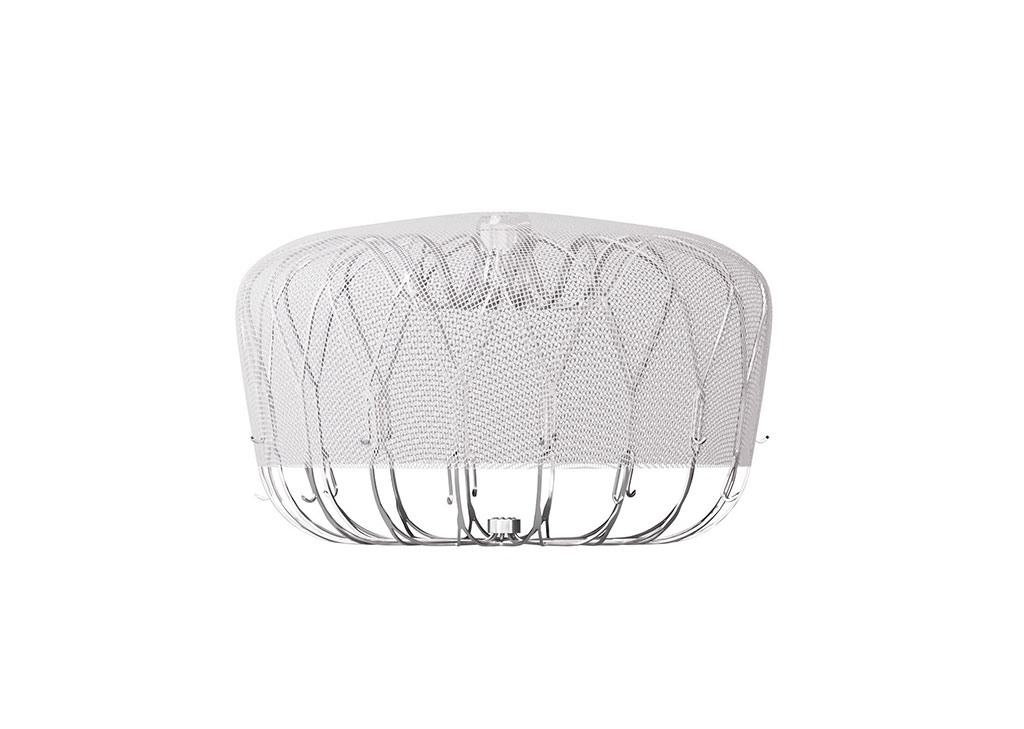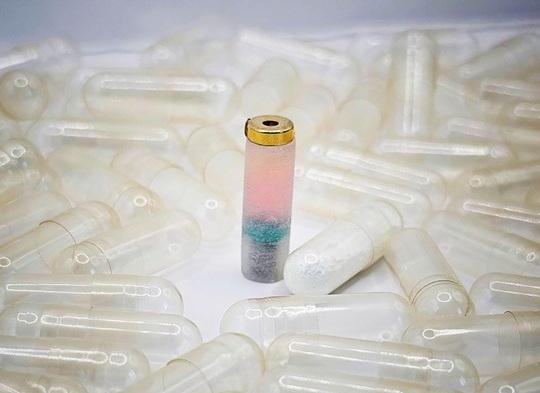LAA Closure Device Reduces Stroke Risk
|
By HospiMedica International staff writers Posted on 28 Jul 2020 |

Image: The Watchman FLX LAA closure system (Photo courtesy of Boston Scientific)
A next-generation left atrial appendage (LAA) closure device offers an alternative to oral anticoagulation therapy for patients with non-valvular atrial fibrillation (AF).
The Watchman FLX, made by Boston Scientific (Natick, MA, USA) is the next generation of the Watchman LAA closure system. It consists of a delivery catheter, an access sheath that serves as a conduit for the delivery catheter, and the LAA closure device itself, which is implanted at (or slightly distal to), the ostium of the LAA, blocking it off to prevent thrombus embolization. Made of a nitinol frame with a polyethylene terephthalate (PET) membrane cap, the new frame design allows for optimal device engagement with the tissue for long-term stability and a faster, more complete seal.
The placement procedure is performed in a catheterization laboratory, using a standard transseptal technique, with the access sheath advanced over a guidewire into the left atrium and onto the distal portion of the LAA over a pigtail catheter. The Watchman is advanced under fluoroscopic guidance and deployed into the LAA, with 10 active fixation anchors providing stability and retention. The Watchman FLX device is available in a range of size options, determined via a transesophageal echocardiogram (TEE). A fully rounded design offers physicians the ability to safely enter, and maneuver within, the LAA.
“Built upon the success of the Watchman platform and thousands of patient-years of clinical research, the next-generation Watchman FLX device is designed to offer increased ease of use for physicians and improved procedural outcomes for patients, including reduced complication risk and healing time,” said Ian Meredith, AM, global chief medical officer of Boston Scientific. “We've set the bar high and look forward to bringing these benefits to a wider range of patients with NVAF who need an alternative to the bleeding risk and lifestyle challenges associated with long-term use of blood thinners.”
The LAA is a small, ear-shaped sac in the muscle wall of the left atrium. Normally, the heart contracts with each heartbeat, and the blood in the left atrium and LAA is squeezed out into the left ventricle. When a patient has AF, the chaotic impulses do not give the atria time to contract, and blood collects and can form clots in the LAA and atria. The LAA is thought to be the source of more than 90% of stroke-causing blood clots that come from the heart in non-valvular AF patients.
Related Links:
Boston Scientific
The Watchman FLX, made by Boston Scientific (Natick, MA, USA) is the next generation of the Watchman LAA closure system. It consists of a delivery catheter, an access sheath that serves as a conduit for the delivery catheter, and the LAA closure device itself, which is implanted at (or slightly distal to), the ostium of the LAA, blocking it off to prevent thrombus embolization. Made of a nitinol frame with a polyethylene terephthalate (PET) membrane cap, the new frame design allows for optimal device engagement with the tissue for long-term stability and a faster, more complete seal.
The placement procedure is performed in a catheterization laboratory, using a standard transseptal technique, with the access sheath advanced over a guidewire into the left atrium and onto the distal portion of the LAA over a pigtail catheter. The Watchman is advanced under fluoroscopic guidance and deployed into the LAA, with 10 active fixation anchors providing stability and retention. The Watchman FLX device is available in a range of size options, determined via a transesophageal echocardiogram (TEE). A fully rounded design offers physicians the ability to safely enter, and maneuver within, the LAA.
“Built upon the success of the Watchman platform and thousands of patient-years of clinical research, the next-generation Watchman FLX device is designed to offer increased ease of use for physicians and improved procedural outcomes for patients, including reduced complication risk and healing time,” said Ian Meredith, AM, global chief medical officer of Boston Scientific. “We've set the bar high and look forward to bringing these benefits to a wider range of patients with NVAF who need an alternative to the bleeding risk and lifestyle challenges associated with long-term use of blood thinners.”
The LAA is a small, ear-shaped sac in the muscle wall of the left atrium. Normally, the heart contracts with each heartbeat, and the blood in the left atrium and LAA is squeezed out into the left ventricle. When a patient has AF, the chaotic impulses do not give the atria time to contract, and blood collects and can form clots in the LAA and atria. The LAA is thought to be the source of more than 90% of stroke-causing blood clots that come from the heart in non-valvular AF patients.
Related Links:
Boston Scientific
Latest Surgical Techniques News
- Minimally Invasive Endoscopic Surgery Improves Severe Stroke Outcomes
- Novel Glue Prevents Complications After Breast Cancer Surgery
- Breakthrough Brain Implant Enables Safer and More Precise Drug Delivery
- Bioadhesive Sponge Stops Uncontrolled Internal Bleeding During Surgery
- Revolutionary Nano Bone Material to Accelerate Surgery and Healing
- Superior Orthopedic Implants Combat Infections and Quicken Healing After Surgery
- Laser-Based Technique Eliminates Pancreatic Tumors While Protecting Healthy Tissue
- Surgical Treatment of Severe Carotid Artery Stenosis Benefits Blood-Brain Barrier
- Revolutionary Reusable Duodenoscope Introduces 68-Minute Sterilization
- World's First Transcatheter Smart Implant Monitors and Treats Congestion in Heart Failure
- Hybrid Endoscope Marks Breakthrough in Surgical Visualization
- Robot-Assisted Bronchoscope Diagnoses Tiniest and Hardest to Reach Lung Tumors
- Diamond-Titanium Device Paves Way for Smart Implants that Warn of Disease Progression
- 3D Printable Bio-Active Glass Could Serve as Bone Replacement Material
- Spider-Inspired Magnetic Soft Robots to Perform Minimally Invasive GI Tract Procedures
- Micro Imaging Device Paired with Endoscope Spots Cancers at Earlier Stage
Channels
Critical Care
view channel
AI Heart Attack Risk Assessment Tool Outperforms Existing Methods
For decades, doctors have relied on standardized scoring systems to assess patients with the most common type of heart attack—non-ST-elevation acute coronary syndrome (NSTE-ACS). The GRACE score, used... Read more
'Universal' Kidney to Match Any Blood Type
Blood-type incompatibility has long been one of the greatest obstacles in organ transplantation, forcing thousands of patients—particularly those with type O blood—to wait years longer for compatible donors.... Read morePatient Care
view channel
Revolutionary Automatic IV-Line Flushing Device to Enhance Infusion Care
More than 80% of in-hospital patients receive intravenous (IV) therapy. Every dose of IV medicine delivered in a small volume (<250 mL) infusion bag should be followed by subsequent flushing to ensure... Read more
VR Training Tool Combats Contamination of Portable Medical Equipment
Healthcare-associated infections (HAIs) impact one in every 31 patients, cause nearly 100,000 deaths each year, and cost USD 28.4 billion in direct medical expenses. Notably, up to 75% of these infections... Read more
Portable Biosensor Platform to Reduce Hospital-Acquired Infections
Approximately 4 million patients in the European Union acquire healthcare-associated infections (HAIs) or nosocomial infections each year, with around 37,000 deaths directly resulting from these infections,... Read moreFirst-Of-Its-Kind Portable Germicidal Light Technology Disinfects High-Touch Clinical Surfaces in Seconds
Reducing healthcare-acquired infections (HAIs) remains a pressing issue within global healthcare systems. In the United States alone, 1.7 million patients contract HAIs annually, leading to approximately... Read moreHealth IT
view channel
Printable Molecule-Selective Nanoparticles Enable Mass Production of Wearable Biosensors
The future of medicine is likely to focus on the personalization of healthcare—understanding exactly what an individual requires and delivering the appropriate combination of nutrients, metabolites, and... Read moreBusiness
view channel
Philips and Masimo Partner to Advance Patient Monitoring Measurement Technologies
Royal Philips (Amsterdam, Netherlands) and Masimo (Irvine, California, USA) have renewed their multi-year strategic collaboration, combining Philips’ expertise in patient monitoring with Masimo’s noninvasive... Read more
B. Braun Acquires Digital Microsurgery Company True Digital Surgery
The high-end microsurgery market in neurosurgery, spine, and ENT is undergoing a significant transformation. Traditional analog microscopes are giving way to digital exoscopes, which provide improved visualization,... Read more
CMEF 2025 to Promote Holistic and High-Quality Development of Medical and Health Industry
The 92nd China International Medical Equipment Fair (CMEF 2025) Autumn Exhibition is scheduled to be held from September 26 to 29 at the China Import and Export Fair Complex (Canton Fair Complex) in Guangzhou.... Read more














